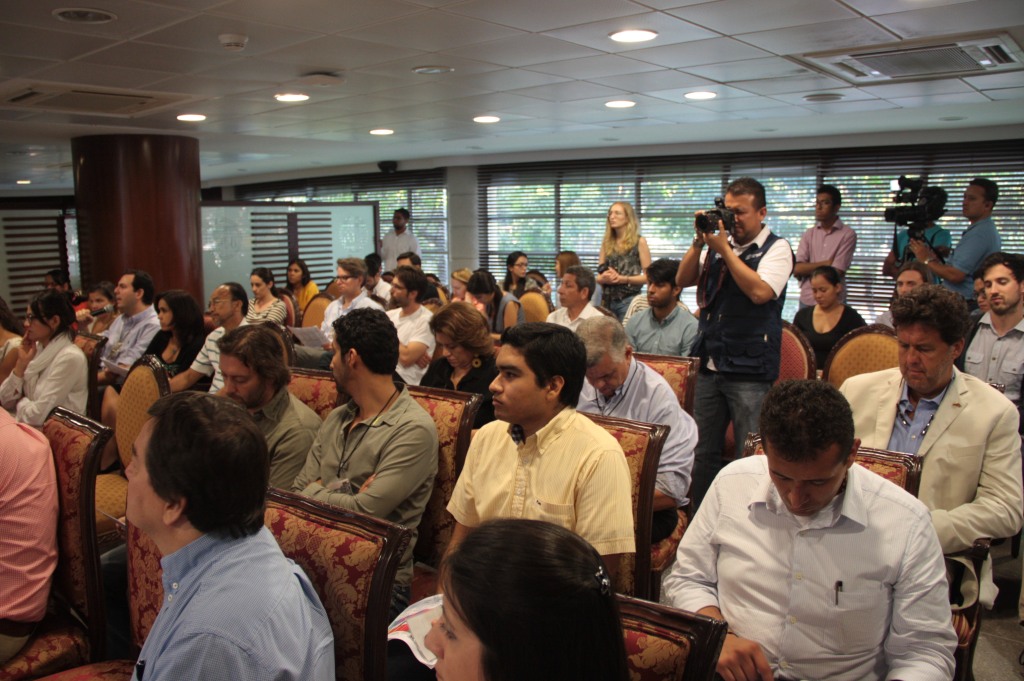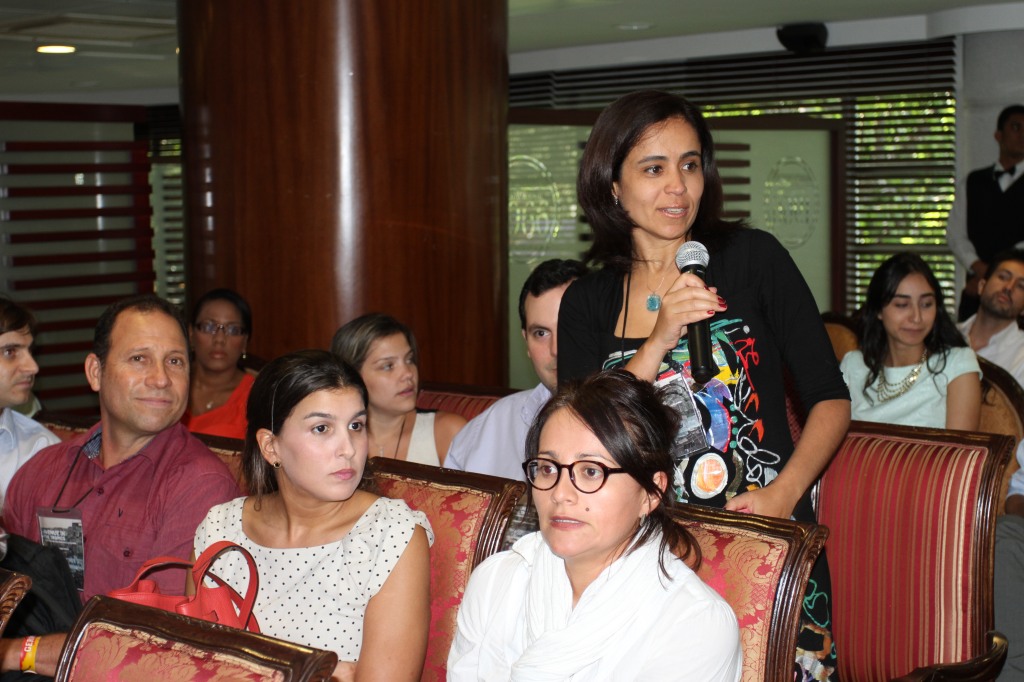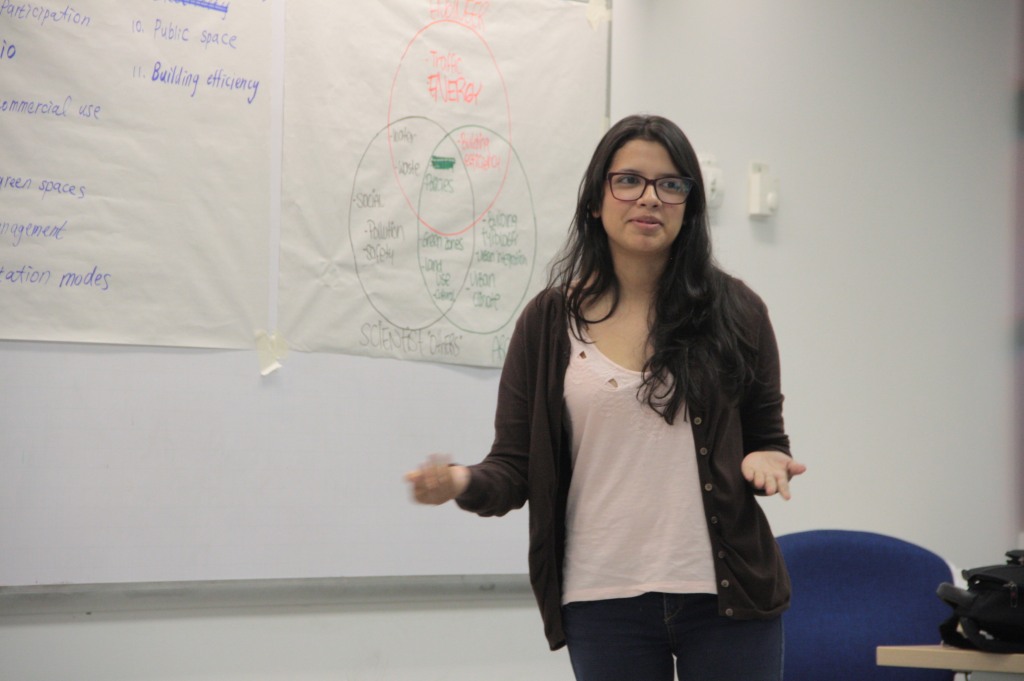
Applications are now open for the 2015 Summer School – apply here: http://marketsinthetropics.com/apply-for-2015/

Applications are now open for the 2015 Summer School – apply here: http://marketsinthetropics.com/apply-for-2015/
As you might have guessed, we are running this summer school right in the middle of the World Cup – and Colombia is doing a fab job of staying in the tournament. Here is the ETH team, sticking to the local colours!
Spanglish – a working language
“The communication between the Columbian and the ETH students was mainly in English. It was sometimes challenging to speak about scientific topics in a foreign language since our English vocabulary was limited. During some difficult discussions and decision-making processes, some Columbian students tend to speak in their native language in the heat of the argument. Thus, the back and forth translation further extended the discussion.
Also during our fieldwork, the language barrier between the people from Calle 30 and the Swiss students was inevitable. It made the analysis of the Avenue more complicated.
But most difficult was the meeting with the stakeholders and experts. The presentations were hold in Spanish as well as the discussion later on. The feedback was summarily translated and therefore some important aspects were missing. It was hard to get all the necessary information.
Even tough a translator was hired for the final presentation on Thursday, it was hard to follow his translation. Too many voices and impressions were distracting.
It is important to know the language of the country you’re working in.”
Fabrice Lacroix
We are all equipped now to present the results to the local decision makers from Barranquilla. In fact there came from as far as Bogota to participate in this event and engage in a discussion on the future of the Calle 30 and the centre of Barranquilla.
The room started filling up with local personalities from public and private sectors – notice the film crew in the background! Prof. Hubert Klumpner and Prof. Manuel Moreno deans of the architecture faculties of ETH and Uni Norte launched the session, before Marcela, a student from our group introduced our summer school and the teams pitched their scenarios.
Our teams brought a series of controversial and challenging urban issues to the forefront. Prompting discussions on priorities, trade-offs and future engagements.
“Para la clausura del Taller, y finalizar el ejercicio de una manera integral, se presentaron las propuestas a activistas del desarrollo de la cidudad de Barranquilla. Esto, teniendo como objetivo de construir en cada uno de estos ejecutores de la semilla para el cambio que los hace cuestionar de sus desiciones en el presente. Explicamos a los responsables de las decisiones nuestro approach, la manera en que desarrollamos los 4 escenarios. Hicimos énfasis en la diferenciación entre los resultados de los escenarios, de manera que ellos pudieran proyectar en su mente lo que la zona representa y en ultimas en lo que desean que se convierta. Con este mismo método se busco llegar hasta sus limites de sus propios paradigmas que los hicieran repensar que es lo que en valioso para ellos del sector. El resultado se tradujo en puntos de opinión diversos desde estos responsables. Al final, el evento sirvió como una excelente ocasión para hacerles ver la importancia de la Calle 30 y los factores que inciden sobre esta, abriéndoles el tema de discusión para debatir posibles soluciones.”
Marcela Gallo & Nhat Anh
“Lo clave para mí fue ver la voluntad que este grupo de personas tenía en escuchar las propuestas sin importar lo radicales o delicadas que estas pudieran ser con el espacio. A pesar que soy un poco escéptica en cuanto a la realización de estos proyectos en corto tiempo, presiento que logramos generarles inquietudes y al menos sembramos la idea; sin embargo insisto que es necesario que se desarrolle un proyecto integral para el área que incluya un trabajo con la ciudadanía en general, tal vez pensando un poco en la generación de una cultura ciudadana para Barranquilla.”
Laura Murcia


Maria Del Rosario Hidalgo Perez, from the Colombian Findeter agency comments on our scenarios.
Our scenarios are nearly ready, and we are going to be hosting a discussion with stakeholders from the Calle, here at the Uni Norte Campus in Barranquilla. We want to present them with our different visions for the future of the Calle 30, and hear what they think of these solutions.
What are the trade-offs they would be ready to make? Which visions do they think are the most feasible? The most desirable?

Here is picture of our stakeholder meeting, in the Uni Norte professors salon – as you can see, the turn out was fantastic.

This session provided an opportunity for local members of the community to share their opinions on the future of the Calle 30, and the main issues affecting it.
Now its back to the table to make our four scenarios.
We are going to use the knowledge we have gathered from our fieldwork and stakeholder groups, and produce four visions by combining the indicators we have selected.
“En el momento de trabajar en las presentaciones nos dividimos en grupos interdisciplinarios y combinados entre estudiantes colombianos y suizos. Toda la experiencia resultó ser muy enriquecedora, debido a los diferentes conceptos y percepciones que tenía cada uno, de acuerdo a su área de estudio. Luego de compartir los primeros días recorriendo el sector de la Calle 30 durante el trabajo de campo y obtener diferentes visiones de lo que sería cada escenario, realizar la presentación y trabajar en equipo fue el espacio ideal para conocernos mejor, compartir experiencias vividas tanto en el recorrido como en las demás actividades, sociales, personales y aquellas propias del tema de estudio, analizamos diferentes puntos de vista relacionados con cada disciplina y debatimos los aspectos más relevantes de lo que sería cada escenario. Después de hacer el trabajo de campo, estudiar la zona y debatir sobre lo estudiado, cada uno de nosotros aprendió a ver las cosas desde un punto de vista general, ampliamos nuestra visión sin obedecer solamente a nuestra perspectiva si no analizando y obteniendo lo mejor de cada uno y añadiéndolo a nuestra forma de pensar.”
Evelyn Castellón
“Dentro del proceso de creación de escenarios los estudiantes presentaron las cuatro visiones ante profesores de la Universidad del Norte. Pertenecientes a diversas disciplinas como economía, sociología arquitectura y diseño urbanístico, entre otros. En esta línea, se buscó la incorporación del aporte de la academia en el proceso de desarrollo de los escenarios que precisamente buscaban promover alguna soluciones a los problemas de la calle 30. Fue muy satisfactoria la intervención de los expertos académicos para brindar visiones técnicas e informadas, además de lo suficientemente críticas para ser enriquecedoras.”
Sara Juliana Gálvez Gutiérrez
During this pretty intense session, we decided upon the main indicators we are going to use to build up our scenarios. Our idea is that each scenario for the future of the Calle 30 is made up of the same indicators that we will vary according to each scenario.

Ingmar led this session like a pro – he made us mediate, talk, and vote until we had fixed our indicators.
After an intense session, these are the indicators and scenarios that we have come up with. As you can see in this graphic below, they vary from land use, to flooding risk and energy efficiency. By combining each of these indicators we hope to be able to build up our four scenarios, our visions for the Calle 30
After our field work – we broke into groups to identify the main issues effecting the Calle 30.
“After the fieldwork in Calle 30 in the morning, we had a brain storming session on developing visions and impact variables. We were asked to write up three visions and 10 impact variables by our individual experiences and observations. Then, all of the students are divided into 2 vision groups and 2 variable groups; each group consisted of students from each disciplinary and two universities. We spend around 2 hours on exchanging ideas within groups and then integrated ideas between vision groups and variable groups. Surprisingly, the two vision groups came up with similar visions at the end. We concluded them into: 1. Pumping Commercio 2. Living la Calle 30 3. Destination El Caño. From the variables teams, they identified feasible impact variables, then those variables were categorized into Engineering, Science and architect related as well as variables involved more than one fields.”
Shan Shan Hsieh
La definición de variables y escenarios fue un proceso enriquecedor debido a que estuvimos interactuando personas de diferentes áreas en conjunto, ver los mismos problemas y darle distintas soluciones de acuerdo a nuestra afinidad. Para cada escenario definimos las mismas variables pero ellas cambiaban en niveles a medida que pasábamos de escenario. Las variables como building efficient y transport pertenecen a ingeniería; Polution y Water Risk son Enviromental; Economics diversity and stratification are social; Land use and density are Arquitecture. La variación la notábamos por ejemplo cuando íbamos estratificar los distintos escenarios: Para destination el caño era 5, living la calle 30 3, pumping comercio 2 and Bussiness as usal 2-1. Asignábamos el estrato según las consideraciones que tomabamos en cada escenario.
Laura Pájaro Santander

Our scenarios needed to pick up on the central issues effecting the area, be it pollution, transport or the lack of public space.
We put our initial vision for the Calle 30 to the test by inviting stakeholders to Uni Norte – they provided feedback, guidance and some new elements we had overlooked in our field work.
“La reunión con los expertos se realizó el miercoles 2 de julio y resultó ser una experiencia enriguecedora que permitió a cada grupo recoger ideas fundamentales de personas con intereses y visiones diferentes, tanto de la sociedad civil como de la academia respecto a la calle 30. En principio se buscó alcanzar uno de los objectivos del curso generando grupos interdisciplinares e interculturales que tuvieron una amena conversación con los expertos dando como resultado la conformación de una suerte de variables de impacto y datos contextuales que posibilitaron una comprensión mas profunda de caso de estudio.”
Sara Juliana Gálvez Gutiérrez